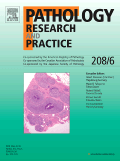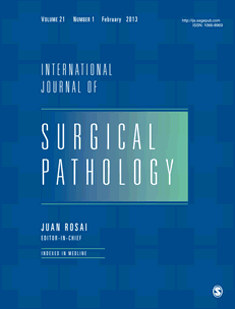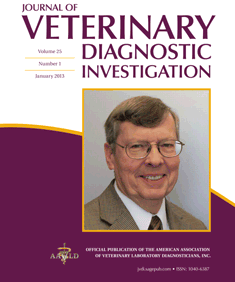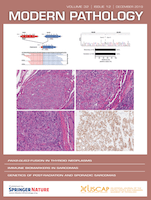
Malaysian Journal of Pathology
Scope & Guideline
Connecting researchers and clinicians through impactful insights.
Introduction
Aims and Scopes
- Clinical and Translational Pathology:
The journal emphasizes the correlation between laboratory findings and clinical outcomes, promoting research that bridges the gap between diagnostic pathology and patient care. - Molecular and Cellular Pathology:
Research in this area explores genetic, molecular, and cellular mechanisms underlying various diseases, with a focus on identifying biomarkers for diagnosis and prognosis. - Infectious Disease Pathology:
Given the regional context, the journal consistently publishes studies related to infectious diseases, including epidemiology, pathogenesis, and laboratory diagnostic advancements. - Oncology and Tumor Pathology:
A significant portion of the journal's content is dedicated to cancer pathology, including studies on tumor markers, histopathological characteristics, and treatment responses. - Forensic Pathology:
The journal includes research related to forensic pathology, highlighting the importance of pathology in legal contexts and the interpretation of post-mortem findings. - Public Health and Epidemiology:
The journal addresses public health issues through pathology, including studies on disease prevalence, risk factors, and the impact of health policies on disease management.
Trending and Emerging
- Digital Pathology and AI Integration:
Emerging research highlights the use of digital pathology and artificial intelligence in diagnostics, showcasing innovative approaches to improve accuracy and efficiency in pathology. - Genomic and Molecular Diagnostics:
There is a growing emphasis on genomic studies and molecular diagnostics, reflecting advancements in personalized medicine and targeted therapies, particularly in oncology. - Pathology of Emerging Infectious Diseases:
The journal has published more studies focusing on emerging infectious diseases, particularly in the context of the COVID-19 pandemic, addressing both clinical implications and laboratory diagnostics. - Public Health and Disease Prevention:
Research addressing public health issues, such as the epidemiology of diseases and preventive measures, is gaining traction, indicating a broader societal focus on health outcomes. - Interdisciplinary Approaches in Pathology:
An increase in interdisciplinary studies that combine pathology with other fields such as genetics, immunology, and bioinformatics is evident, promoting a holistic understanding of disease mechanisms.
Declining or Waning
- Traditional Histopathological Techniques:
There has been a noticeable decrease in publications focusing solely on conventional histopathological techniques, as the field moves towards more advanced and integrated methodologies. - General Case Reports:
The journal appears to be publishing fewer general case reports, favoring studies that contribute to broader knowledge bases or that have significant clinical implications. - Basic Pathology Education:
Research and publications aimed at basic pathology education and training have become less frequent, possibly overshadowed by more specialized or advanced topics. - Single-Center Studies:
There is a trend towards multicenter studies or larger cohort analyses, leading to a decline in the number of single-center studies being published.
Similar Journals

PATHOLOGY RESEARCH AND PRACTICE
Advancing the Frontiers of Pathological SciencePATHOLOGY RESEARCH AND PRACTICE is a premier journal in the field of pathology and forensic medicine, published by Elsevier GmbH in Germany. With a rich publication history since 1978 and an impressive convergence period extending to 2024, this journal serves as a vital resource for researchers and professionals dedicated to advancing the understanding of pathological processes. It holds notable rankings, including Q3 in Cell Biology and Q2 in Pathology and Forensic Medicine for 2023, reflecting its significance in the academic community. The journal aims to publish innovative research findings, reviews, and case studies, facilitating a deeper understanding of disease mechanisms and improving diagnostic practices. Authors and readers alike benefit from its reputable platform, noted for its challenging and rigorous peer-review process. By fostering a collaborative environment and providing open access options, PATHOLOGY RESEARCH AND PRACTICE continues to contribute meaningfully to the discourse within its respective fields, thereby appealing to a diverse audience of researchers, professionals, and students.

VIRCHOWS ARCHIV
Elevating Understanding in Pathological and Forensic MedicineVirchows Archiv, published by Springer, is an esteemed journal dedicated to the fields of Medicine and Pathology, featuring high-quality research from various domains including Cell Biology and Molecular Biology. With its inception dating back to 1947, Virchows Archiv has been a pivotal platform for advancing the understanding of pathological and forensic medicine. As evidenced by its impressive Scopus rank, placing it within the top 15% of journals in Pathology and Forensic Medicine, it continues to maintain a strong presence with a Q1 classification in its category as of 2023. Although it does not offer Open Access options, the journal remains critical for researchers and professionals seeking to publish and access pioneering findings that can impact clinical practices and the academic community. The journal’s rigorous peer-review process ensures that only the highest quality research is disseminated, making it an essential resource for those engaged in the ever-evolving fields of health and biological sciences.

LABORATORY INVESTIGATION
Advancing the Frontiers of Laboratory ScienceLaboratory Investigation is a premier academic journal published by Elsevier Science Inc, specializing in the fields of Pathology, Forensic Medicine, Cell Biology, and Molecular Biology. With its ISSN 0023-6837 and E-ISSN 1530-0307, this journal has been a significant contributor to scientific discourse since its inception in 1952, converging into its current form by 2024. It holds an impressive standing in its respective fields, featuring a 2023 Journal Rank of Q2 in both Cell Biology and Molecular Biology, and an elite Q1 ranking in Pathology and Forensic Medicine, reflecting its influence and quality of research, as seen in its Scopus ranks—17th out of 208 in Pathology and Forensic Medicine. Although it does not offer Open Access options, the journal remains a vital resource for researchers, professionals, and students who seek to disseminate and engage with high-caliber research findings. The importance of Laboratory Investigation is underscored by its commitment to advancing the understanding of laboratory and translational medicine, paving the way for innovations that enhance clinical practices.

INTERNATIONAL JOURNAL OF SURGICAL PATHOLOGY
Elevating Standards in Surgical DiagnosticsInternational Journal of Surgical Pathology is a distinguished peer-reviewed journal published by SAGE Publications Inc since 1993, specializing in the intricate fields of surgical pathology, anatomy, and surgery. With an ISSN of 1066-8969 and an E-ISSN of 1940-2465, this journal has been at the forefront of disseminating vital research that helps shape clinical practices and understanding in surgical diagnostics. Ranked in the Q2 category for Anatomy and garnering Q3 status in Pathology and Forensic Medicine as well as Surgery, the journal holds a commendable position within its field as reflected by its Scopus ranks. The impact factor underscores its influence and relevance, making it an essential resource for researchers, professionals, and students alike, looking to stay abreast of advancements in surgical pathology. However, please note that the journal does not currently offer open access options. As it converges through the years from 1993 to 2024, the International Journal of Surgical Pathology continues to uphold its commitment to excellence in medical research.

JOURNAL OF VETERINARY DIAGNOSTIC INVESTIGATION
Elevating standards in veterinary diagnostics for better animal care.The JOURNAL OF VETERINARY DIAGNOSTIC INVESTIGATION, published by SAGE PUBLICATIONS INC, stands as a pivotal resource in the field of veterinary medicine, focusing on the latest advancements in diagnostic methodologies and their application in animal health. With an impressive impact factor and ranked in the Q1 category of Veterinary (miscellaneous) for 2023, this journal ensures the dissemination of high-quality research that is critical for veterinarians, researchers, and students alike. Established in 1989 and set to continue through 2024, it encompasses a broad spectrum of topics, vital for professionals committed to enhancing veterinary diagnostics. The journal's rigorous peer-review process guarantees that only the most innovative and thorough research contributions reach its audience, fostering an environment of academic excellence and knowledge transfer in the veterinary diagnostic field.

INTERNATIONAL JOURNAL OF BIOLOGICAL MARKERS
Connecting Global Minds in Oncology and PathologyWelcome to the International Journal of Biological Markers, a distinguished publication under SAGE Publications Ltd that has been a vital resource in the fields of Cancer Research, Clinical Biochemistry, Oncology, and Pathology and Forensic Medicine since its inception in 1986. With a commitment to disseminating high-quality research, the journal enjoys a robust impact highlighted by its Q2 and Q3 rankings across multiple categories in 2023, as evidenced by its Scopus rankings placing it in respectable percentiles. Based in Italy, this journal serves a global audience of researchers, clinicians, and students eager to keep abreast of the latest discoveries involving biological markers and their applications in medicine. Emphasizing rigorous peer review and scholarly integrity, the International Journal of Biological Markers plays a crucial role in advancing knowledge that can significantly impact clinical practices and enhance patient care.

JOURNAL OF COMPARATIVE PATHOLOGY
Innovating Understanding in Veterinary SciencesJOURNAL OF COMPARATIVE PATHOLOGY, published by Elsevier Science Ltd, stands as a significant publication within the fields of pathology and forensic medicine, as well as veterinary studies. With an ISSN of 0021-9975 and an E-ISSN of 1532-3129, this journal has been disseminating critical research since 1950, contributing to the advancement of knowledge through its focus on comparative pathology. The journal's reputable standing is underscored by its Q3 classification in Pathology and Forensic Medicine and Q2 in Veterinary (miscellaneous) for 2023, reflecting its vital role in shaping contemporary discourse in these domains. The Scopus ranks further solidify its presence, placing it at the 51st percentile in general veterinary sciences and the 32nd percentile in pathology—a testament to the quality and relevance of the contributions it publishes. Although it operates under a subscription model, the journal remains accessible to researchers and practitioners who aim to deepen their understanding of pathological phenomena across species, enhance diagnostic accuracy, and improve clinical practices. With a steadfast commitment to rigorous peer review and a global readership, the JOURNAL OF COMPARATIVE PATHOLOGY is an essential resource for those engaged in research and professional practice, fostering collaborations and innovations that bridge complementary areas of study.

PATHOLOGICA
Unveiling Insights in Pathology and Forensic Medicine.PATHOLOGICA is a leading academic journal dedicated to the field of pathology and forensic medicine, published by PACINI EDITORE. With a rich history dating back to its inception in 1945, the journal has consistently contributed to the advancement of knowledge in these vital areas of medical research and practice. Currently ranked in the Q1 quartile for Pathology and Forensic Medicine and holding an impressive position as #42 out of 208 in the Scopus rankings, it reflects a significant impact within the academic community, boasting an 80th percentile ranking. The journal is committed to publishing high-quality, peer-reviewed articles that explore innovative research findings and clinical advancements, making it an essential resource for researchers, clinicians, and students alike. Though it does not offer open access, PATHOLOGICA continues to foster scholarly communication by disseminating cutting-edge research findings, thus playing a pivotal role in enhancing pathology education and practice worldwide.

Oral & Maxillofacial Pathology Journal
Bridging Research and Practice in Maxillofacial PathologyOral & Maxillofacial Pathology Journal is a prominent peer-reviewed publication dedicated to advancing the field of oral and maxillofacial pathology. Published by the KAIRALI SOCIETY OF ORAL & MAXILLOFACIAL PATHOLOGISTS, this journal aims to provide a platform for sharing innovative research, clinical practices, and new techniques related to the diagnosis and management of oral diseases. With a commitment to open access, it ensures that valuable knowledge reaches a global audience of researchers, dental professionals, and students alike. Although specific impact metrics such as the HIndex and Scopus ranking are not listed, the journal is regarded as an essential resource for those involved in the oral health community. It plays a crucial role in fostering collaboration and disseminating cutting-edge advancements that can enhance patient care and clinical outcomes in oral pathology. For professionals looking to stay ahead in this dynamic field, Oral & Maxillofacial Pathology Journal serves as an indispensable tool for both foundational learning and advanced research.

MODERN PATHOLOGY
Innovating Diagnostic Excellence in PathologyMODERN PATHOLOGY is a premier journal in the field of pathology and forensic medicine, published by Elsevier Science Inc. With an impressive impact factor that places it in the top 1st quartile (Q1) for 2023, and a remarkable rank of 5 out of 208 in its category according to Scopus, it serves as a vital resource for researchers, professionals, and students alike. Established in 1988, the journal focuses on the latest advancements in diagnostic pathology, molecular pathology, and related fields, providing a platform for innovative research that drives the discipline forward. Although it does not operate under an open access model, readers can expect rigorously peer-reviewed publications that contribute to the growing body of knowledge in pathology. With a continuous commitment to excellence and relevance, MODERN PATHOLOGY remains a fundamental avenue for disseminating high-quality scientific research globally, facilitating the growth and development of its field.